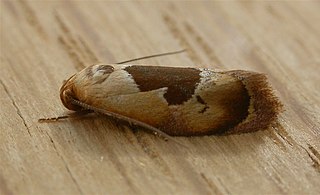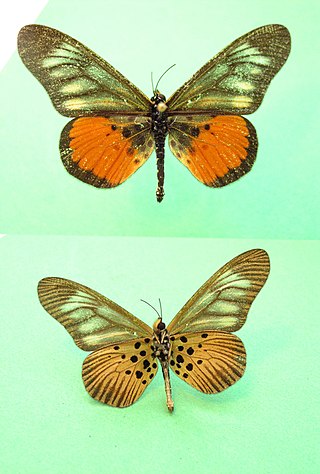
Hoplomorpha camelaea is a moth in the family Oecophoridae first described by Edward Meyrick in 1888. It is found in Australia, where it has been recorded from Victoria, Queensland, New South Wales and the Australian Capital Territory.

Acraea pelopeia is a species of butterfly in the family Nymphalidae. It is found from Cameroon to the eastern part of the Democratic Republic of the Congo and in the Central African Republic.
Idiophantis chiridota is a moth of the family Gelechiidae. It was described by Edward Meyrick in 1914. It is found in Sri Lanka, Thailand, on the Sunda Islands and Fiji.
Photodotis prochalina is a moth of the family Gelechiidae. It was described by Edward Meyrick in 1911. It is found in South Africa.
Stenoma melixesta is a moth of the family Depressariidae. It is found in Colombia.
Timocratica maturescens is a moth of the family Depressariidae. It is found in French Guiana, Colombia and Venezuela.
Timocratica philomela is a moth of the family Depressariidae. It is found in Peru.
Timocratica leucocapna is a moth of the family Depressariidae. It is found in Colombia, Costa Rica, Peru and Venezuela.
Antaeotricha generatrix is a moth of the family Depressariidae. It is found in Brazil.
Antaeotricha lysimeris is a moth of the family Depressariidae. It is found in Peru.
Timocratica megaleuca is a moth of the family Depressariidae. It is found in Colombia.
Antaeotricha modulata is a species of moth of the family Depressariidae. It is found in Brazil, Guyana and French Guiana.
Stenoma platyterma is a moth of the family Depressariidae. It is found in Guyana.
Antaeotricha humerella is a moth of the family Depressariidae. It is found in Brazil (Amazonas), French Guiana, Guyana and Panama.
Antaeotricha ptycta is a species of moth of the family Depressariidae. It is found in Guatemala, Panama, Ecuador, the West Indies and Guyana.
Falculina lepidota is a moth of the family Depressariidae. It is found in French Guiana.
Doxogenes spectralis is a moth in the family Lecithoceridae. It was described by Edward Meyrick in 1905. It is found in Sri Lanka.
Antaeotricha celidotis is a moth in the family Depressariidae. It was described by Edward Meyrick in 1925. It is found in Peru.
Timocratica pompeiana is a moth in the family Depressariidae. It was described by Edward Meyrick in 1925. It is found in Peru.
Timocratica monotonia is a moth in the family Depressariidae. It was described by Embrik Strand in 1911. It is found in Brazil (Amazonas), Guyana, Venezuela, Colombia, Ecuador and Peru.

